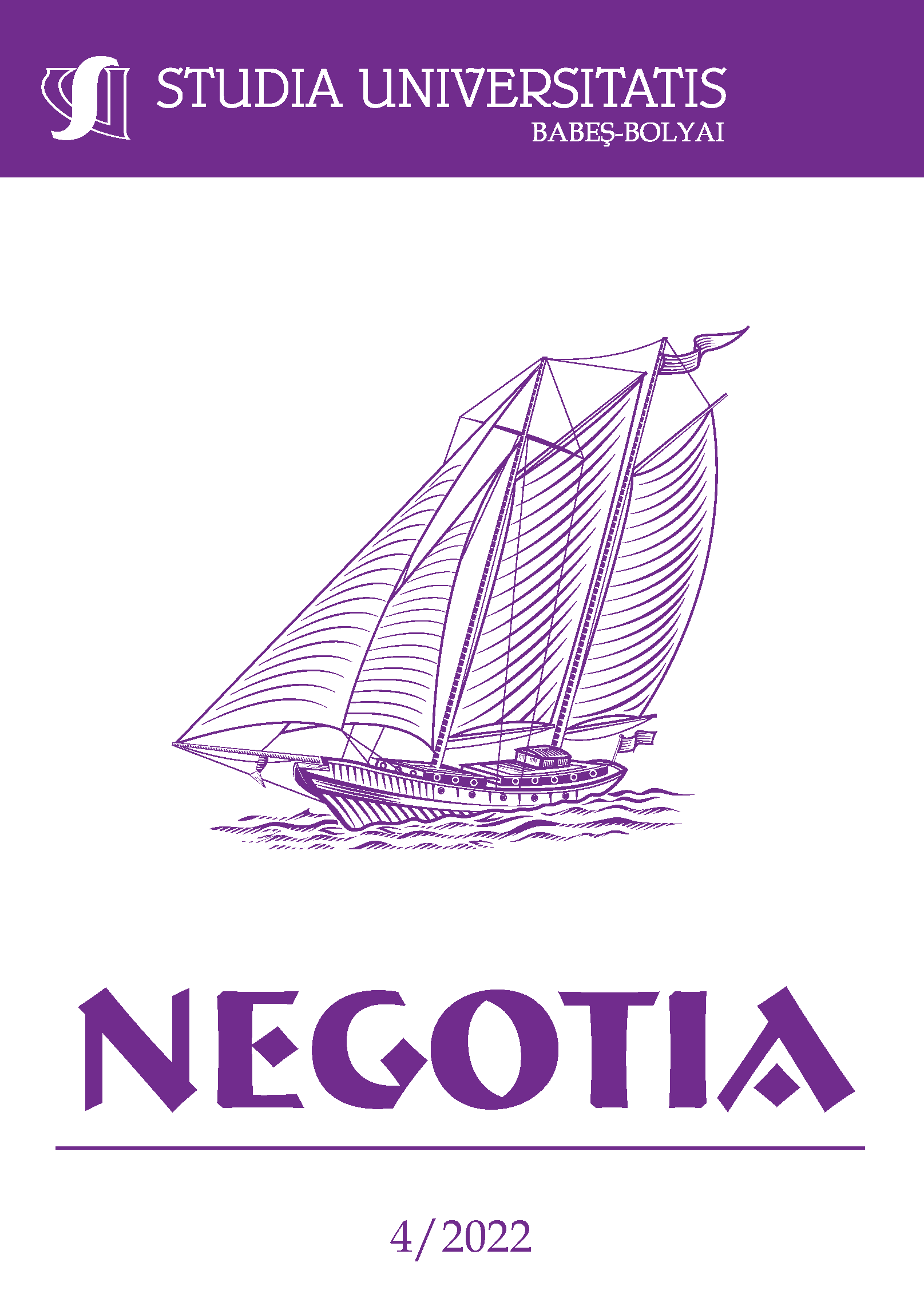SYNERGY EFFECT: HOW TO CAPTURE VALUE IN THE BUSINESS STRATEGY? A CASE OF IT BUSINESSES IN NORTH MACEDONIA
DOI:
https://doi.org/10.24193/subbnegotia.2022.4.01Keywords:
synergy, business strategy, inter-organizational relations, competitive advantage.Abstract
Nowadays, businesses are required to create added value and difference. In recent years, the synergy perspective grew into one of the main concerns of corporate and strategic management. It creates a new path for change in the way of designing the business strategy, characterized by the collaboration mindset embedded in the overall strategic thinking context. This paper investigates the perceptions and practices of the IT managers with regards to the potential of synergy strategies. It aims to explore the growing importance of synergies between all elements, stakeholders, and processes in the organization, with a particular emphasis on the connections which include cooperation, interaction and working together to realize accepted purposes and strategic goals. The primary data were obtained through a survey carried out in the IT businesses in North Macedonia and evaluated by using the descriptive statistics. The key findings indicate that synergy strategies can create added value on the company’s sustained competitive advantage. The results showed that the synergy strategy appears to be a good managerial practice to be fostered on the organizational level to produce greater results. As the synergy effects seem to be a widespread practice, but rarely discussed topic within the IT sector in North Macedonia, the research will attempt to provide a theoretical contribution to the academic community, but also to help local managers to identify and coordinate opportunities for integrating the sinergy in their business strategy. Apart from the main research focus, our aim expands further to making a broader contribution to the theories of strategy and organization.
JEL codes: L19, M10
References
Altay, A. and Kayakutlu, G. (2012), “Collective Intelligence for Evaluating Synergy in Collaborative Innovation”, 1st IFIP International Workshop on Artificial Intelligence for Knowledge Management (AI4KM), Montpellier, France. pp.131-150
Ansoff, H. L. (1965), Corporate Strategy, McGraw-Hill, New York.
Antikainen, M.J. and Vaataja, H.K. (2010), “Rewarding in Open Innovation Communities—How to Motivate Members”, International Journal of Entrepreneurship and Innovation Management, Vol.11, pp.440-456.
Barney, J. B. (1991), “Firm Resources and Sustained Competitive Advantage”, Journal of Management, Vol.17, pp. 99-120
Birkinshaw, J., Hamel, G. and Mol, M.J. (2008), “Management innovation”, Acad. Manag., Vol.33, pp.825–845.
Bititci, U., et all. (2007), “Managing synergy in collaborative enterprise”s, Production Planning & Control, Vol.18 No. 6, pp.454–465
Blomqvist, M., Holmberg, K., Fernell, E., Ek, U. and Dahllof, G. (2006), “Oral Health, Dental Anxiety, and Behavior Management Problems in Children with Attention Deficit Hyperactivity Disorder”, European Journal of Oral Sciences, Vol.114, pp.385-390.
Daliker, K. (2011), Knowledge Management in Theory and Practice (Second Edition), USA: The MIT PRESS
Daneshvar, P. and Ramesh, H. N. (2012), “Determination of IT strategies to improve bank’s performance- Indian Public banks experience”, Asian Journal of Research in Business Economics and Management, Vol. 2 No.2.
Du, Y. Zhou, H., Yuan, Y. and Liu, X. (2019), "Explore Knowledge-Sharing Strategy and Evolutionary Mechanism for Integrated Project Team Based on Evolutionary Game Model", Advances in Civil Engineering, https://doi.org/10.1155/2019/4365358
Eriksson, I. V. and Dickson, G. W. (2000),"Knowledge Sharing in High Technology Companies", AMCIS 2000 Proceedings, pp.217, http://aisel.aisnet.org/amcis2000/217
Goold, M. and Campbell, A. (1998), “Desperately seeking synergy”, Available online at: https://hbr.org/1998/09/desperately-seeking-synergy [Accessed on 20/01/2021].
Griffith, T.L., Sawyer, J.E. and Neale, M.A. (2003), “Virtualness and knowledge: Managing the love triangle of organizations, individuals, and information technology”, MIS Quarterly, Vol.27, pp.265-287.
Jasińska M. (2019), “Synergy in a team-quality analysis of conditions”, Zeszyty Naukowe Uniwersytetu Przyrodniczo-Humanistycznego w Siedlcach, Vol.120 No.47.
Kaplan, R. S. and David P. (2006), “Alignment: Using the Balanced Scorecard to Create Corporate Synergies”, Boston: Harvard Business School Press.
Porter, R. (1987), “Mind-forg’d manacles: A history of madness in England from the Restoration to the Regency”, Harvard University Press.
Potter, R. E. and Balthazard, P. (2004), "The Role of Individual Memory and Attention Processes During Electronic Brainstorming," MIS Quarterly, Vol.28 No.4.
Ruan, P.N. and Han, P.H. (2012), “Synergy Effect of Knowledge Sharing between the Nodes in Network Organization”, AMM Vol. 197, pp. 564–570.
Sirower, M. L. (1997), The synergy trap, New York: The Free.
Tršková K.and Holubčík M. (2016), “Leadership and Motivation of Human Potential as Vital Part of Strategic Management of Cooperation in Company”, 13th International Scientific Conference Human Potential Development, Szczecin, University of Szczecin.
Turban, E., et al. (2008), A Managerial Perspective. Electronic Commerce 2006, Pearson Education Inc., Upper Saddle River.
Wang, C. L. and Ahmed, P. K. (2004), “The development and validation of the organisational innovativeness construct using confirmatory factor analysis”, European journal of innovation management.
Weiss, E.S., Anderson, R.M. and Lasker, R.D. (2002), “Making the Most of Collaboration: Exploring the Relationship Between Partnership Synergy and Partnership Functioning”, Health Education & Behavior.Vol.29 No.6, pp. 683-698. doi:10.1177/109019802237938
Witcher, B. J. and Chau, V. S. (2010), Strategic Management: Principles and Practice, South-Western Carolina, Cengage Learning.
Zack, M., McKeen, J.and Singh, S. (2009), “Knowledge management and organisational performance: An exploratory survey”, Journal of Knowledge Management, Vol.13 No.6, pp.392–409.
Downloads
Published
How to Cite
Issue
Section
License
Copyright (c) 2022 Studia Universitatis Babeș-Bolyai Negotia

This work is licensed under a Creative Commons Attribution-NonCommercial-NoDerivatives 4.0 International License.



